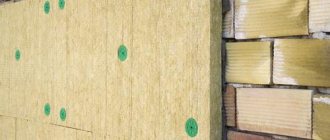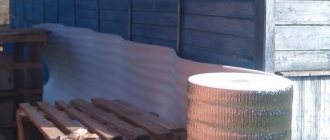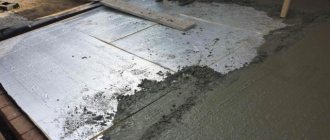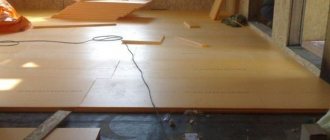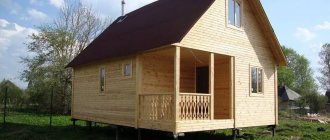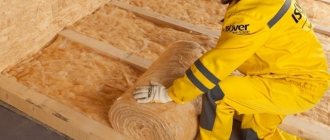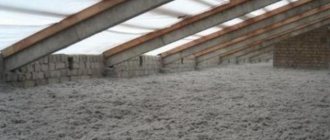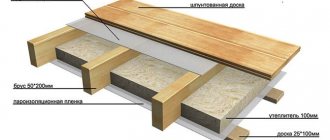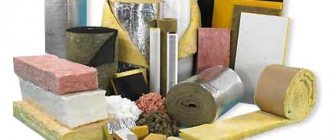Thermal insulation of the floor largely determines both the ease of use of a living space and the cost of heating it. To insulate the mentioned structure, a wide variety of materials are used: from budget sawdust and other fillers to traditional mineral wool and foam boards and modern sprayed compounds. Compared to most available types of insulation, Isolon stands out favorably - a material made on the basis of foamed polyethylene with an additional coating in the form of aluminum foil.
Floor insulation with isolon
Next, you are invited to familiarize yourself with the basic information about this modern insulation and study the instructions for its installation in the case of arranging floors made of different materials.
Izolon foil
Floor insulation with isolon
Author: Nikolay Strelkovsky
Thermal insulation of the floor largely determines both the ease of use of a living space and the cost of heating it. To insulate the mentioned structure, a wide variety of materials are used: from budget sawdust and other fillers to traditional mineral wool and foam boards and modern sprayed compounds. Compared to most available types of insulation, Isolon stands out favorably - a material made on the basis of foamed polyethylene with an additional coating in the form of aluminum foil.
Floor insulation with isolon
Next, you are invited to familiarize yourself with the basic information about this modern insulation and study the instructions for its installation in the case of arranging floors made of different materials.
Which side should I place the isolon on the floor?
Experts advise in any case to carry out insulation with the foil surface directed towards the inside of the room. In this way, it is possible to block the leakage of radiant heat and at the same time strengthen the vapor barrier of the floor.
An exception may be a scheme with two-layer insulation of plank floors on wooden logs, provided that water heating is used in the house. For example, when laying the bottom layer of mineral wool, you can lay foil-coated polyethylene foam with aluminum foil to the mineral wool. This is done in order to block the seepage of supercooled water vapor through the layer of polyethylene foam insulation. The foil perfectly traps vapors, prevents moisture from condensing and forces it to escape through the air gap between the isolon and the mineral wool.
Basic performance properties of isolon
To get a complete picture of the proposed thermal insulation material, read the description of its main performance properties given in the following table.
ISOLON - elastic thermal insulation, available in a wide range of densities and thicknesses
Table. Properties of isolon
| Properties of isolon | Description |
| Reflective effect | One of the main advantages of isolon is its high reflective effect, which contributes to an additional and very noticeable reduction in heat loss. |
| Compatibility with other materials | The properties of isolon allow it to be used both in combination with wooden structures and for insulating concrete floors. |
| Thickness | Compared to many other thermal insulation materials, isolon stands out favorably with its modest thickness, averaging 2-10 mm (sometimes up to 15 mm). Despite this, the material copes with the tasks assigned to it without any complaints. |
| Moisture permeability | The insulation does not absorb moisture, which makes it possible to count on its maximum long-term operation without reducing its thermal insulation characteristics. |
| Environmental friendliness | Isolon is not harmful to human health or the environment, which allows it to be used in premises for any purpose. |
| Other properties | Izolon is characterized by a long service life. The material is not subject to rotting. If necessary, izolon can be used in combination with other insulation materials. In addition to excellent thermal insulation characteristics, izolon has good noise absorption properties, which is an additional advantage. |
Recommendations and common mistakes
The first mistake appears due to the desire to save. Insulation based on Izolon is quite expensive, so even pieces and small pieces are used. In practice, this means the appearance of a large number of cold bridges at the joints. Pasted tape provides only a mechanical connection; it will not protect against heat loss. Therefore, insulation must be laid with a minimum number of panels.
The second mistake is related to the refusal to use vapor barrier and waterproofing. Membranes must be used without fail; Izolon is capable of absorbing moisture up to 0.01%. This is not much, but it is enough to lead to a sharp increase in the thermal conductivity of the material upon contact with water.
Types of foil insulation
Traditionally, isolon is sold in the form of rolls, but the thickest types of insulation (usually 15 mm) can also be produced in the form of sheets of a standardized size.
Polyethylene foam insulation comes in three main varieties:
Also, the insulation materials under consideration are classified depending on the properties of the source material. Thus, budget varieties are most often produced on the basis of ordinary polyethylene. The material is foamed repeatedly during production. As a result, a closed porous gas-filled structure is created. Such insulation has 2 main disadvantages: a tendency to shrink and low resistance to deformation loads.
More attractive in terms of performance characteristics is thermal insulation material made from the so-called. "cross-linked" polyethylene. Such insulation has a much higher density, withstands mechanical loads better and tends to restore its original shape after the cessation of dynamic influences.
ISOLONTAPE self-adhesive material coated with glue on one or both sides
How to put isolon under an electric heated floor
The first thing you will need to do is lay out the base for laying the thermal insulation. The subfloor can be poured in the form of a screed or assembled from a moisture-resistant plasterboard sheet. In any case, the surface should be as smooth and flat as possible.
Installation of isolon is carried out in the following order:
- We treat the base with a primer;
- We lay Izolon 100 without foil on the floor, carefully glue the joints, the edges should be laid on the walls with an allowance of 30 mm;
- The next layer is made of foil Isolon 500, it is best to lay two layers 10 mm thick with seams spaced apart;
- The sheets are laid out on the floor with the foil facing up and also taped with metallized tape;
- Depending on the design of the heated floor, it will be necessary to install fastenings for heating pipes or cables on the insulation surface. In this case, the floor is covered with screed under the tiles.
For wooden floors, before laying the heating elements, support bars are laid, and only after that the cable or plastic pipes for the coolant are installed. All that remains is to connect the heating, check and cover the floor with a tongue and groove board.
The procedure for installing thermal insulation
You are offered instructions for arranging thermal insulation, including isolon and additional insulation in the form of mineral wool (can be replaced with polystyrene foam/polystyrene foam or other insulation of your choice).
If you wish, you can not arrange the second layer of the structure. For example, in the case of installing thermal insulation in an apartment in combination with a heated floor heating system, or while simultaneously using insulation as a substrate for laminate, you can limit yourself to using only isolon. The relevant instructions remain the same. For the rest, be guided by the features of the location and operation of the premises being equipped and your personal preferences.
Floors with heating pipes and ducts, the so-called “warm” floors, have become widespread in the construction of residential buildings. Foil-coated ISOLON is used as reflective insulation in the construction of such floors. Possible material options ISOLON 500, ISOLON 300 3-5 mm foil
First stage. Dismantling the coating
If you plan to insulate a floor that has already been in use, you will have to perform a number of preparatory measures, the first of which is the dismantling of the existing floor covering. We get rid of it and take the garbage out of the room.
The old floor should be removed
Second phase. Preparing the foundation
After getting rid of the old finishing, examine the condition of the underlying structure. Get rid of peeling and cracked screed down to the very base. If the finishing was laid on top of a wooden structure, replace the damaged elements with new ones or, if there is significant damage, install a new structure after first getting rid of the old one.
If necessary, strengthen the base, focusing on the characteristics of a particular situation. For example, if the floor of a balcony is being insulated, examine the condition of the parapet, make sure that the joints of the structural elements are intact, etc. Blow out any cracks found with foam. To eliminate individual defects in the concrete floor, use appropriate building mixtures, for example, cement-sand mortar. If significant differences in surface height are detected, it makes sense to pour a new screed with a thickness of about 30-40 mm.
Floor leveling screed
In the case of insulation of a wooden structure, isolon, as a rule, is laid on top of the subfloor, presented in the form of a flooring made of material chosen by the owner (plywood, boards, etc.). This provision may vary, depending on the specifics of your specific situation. For example, it may be necessary to insulate the floor with isolon along the joists.
Laying isolon on the subfloor
In this case, the following is done:
Third stage. We arrange waterproofing
The necessary hydro- and vapor barrier of the floating floor is provided by a layer of IZOLON material. For hydro- and vapor barrier of a floating floor, the material ISOLON 500, ISOLON 300 4-8 mm is suitable
Cover the base with a suitable primer. Let the coating dry for the time recommended by the manufacturer of the selected primer. After this, we cover the surface with a simple plastic film or a special waterproofing membrane.
When laying waterproofing, we place the edges of the film at approximately 10-15 cm of the height of the walls and secure them with a stapler, nails or other suitable method. Pieces of film are laid with a 10-15 cm overlap. The joints are fixed with adhesive tape.
If desired, you can give preference to coating waterproofing. The work comes down to applying two layers of bitumen mastic, each 1-1.5 mm thick, onto a previously dust-free base. Before applying a new layer, take a break recommended by the manufacturer of the waterproofing composition.
Fourth stage. Laying the first thermal insulation layer
The necessary thermal insulation of the floor is provided by a layer of ISOLON. Material used: ISOLON 500, ISOLON 300 4-10 mm
If necessary, we adjust the rolled/sheet insulation material to size and lay the cut on top of the waterproofing layer. We fill the entire surface with pieces of isolon, making sure that there are no gaps at the joints, because Because of them, the thermal insulation properties of the structure will deteriorate. We glue the joints directly with foil tape.
If laying a second layer of insulation is not provided, cover the isolon with waterproofing material and proceed with arranging the final finish in accordance with the chosen technology. When installing two-layer insulation, follow the steps described below.
Fifth stage. Installing logs
We cut the wooden beam pre-treated with antiseptic impregnation into the required number of elements along the length (for small rooms such as a balcony, it can be along the width) of the base and install it on top of the insulation. We place the outermost logs directly next to the walls. We place intermediate ones in 0.5-0.6 meter increments. We check the evenness of the installation of the logs using a level. After making sure that there are no differences, we fix the elements using dowels and self-tapping screws. There must be at least 4 fastenings for each lag. We screw in the outer fasteners, departing from the ends of the beam about 70 mm.
Sixth stage. Laying the second thermal insulation layer
Insulation is laid between the joists
We place the selected thermal insulation material in the space between the joists. The insulation must first be adjusted to the size of the formed cells and laid as tightly as possible, without gaps. If there are cracks, we get rid of them in a suitable way, for example, by blowing them out with foam.
Example of laying mineral wool
We lay a layer of waterproofing material on top of the mineral wool insulation. To fix the film to the joists, we use any suitable method. For example, protective material can be secured using a stapler.
Seventh stage. Finishing the job
Finally, all we have to do is lay the finishing flooring on top of the joists. For its arrangement, boards with a thickness of 3 cm or sheet plywood are traditionally used. We lay the elements perpendicular to the joists and fix them with nails or self-tapping screws.
Finally, all we have to do is lay the finishing flooring on top of the joists.
Now we only need to arrange the selected finishing material - it will lie on a flat and insulated area without any problems.
| Type of coverage | Service life, years | Decorativeness | Ease of maintenance | Resistance to mechanical loads | Environmental friendliness | Maintainability |
| Parquet | 15-20 | average | average | not high | high | low |
| Linoleum | 3-7 | low | easily | not high | low | Can not be repaired |
| Tile | 5-15 | average | average | average | high | average |
| Carpet | 1-5 | low | hard | not high | low | Can not be repaired |
| Laminate | 3-7 | low | average | not high | low | Can not be repaired |
| Polymer | 10-30 | high | easily | high | high | high |
| Evaluation criterion | Laminate | Parquet | Cork materials | Solid floor board |
| Environmental Safety | Completely artificial material | Without varnish and glue, it is completely natural | Absolutely environmentally friendly and safe coating | Environmental friendliness at the highest level |
| Duration of operation | Traditionally up to 5-15 years | Up to 50 years, depending on the thickness of the base layer | At least 45-50 years old | Average – 35-40 years |
| Moisture resistance | Low | Low | Increases after waxing | Increases after impregnation with appropriate products |
| Thermal insulation indicators | Low | High | Very high | High |
| Difficulty of installation | Easy to set up | Requires professional skills | Can be installed independently, depending on the chosen installation method | Self-installation possible, basic skills required |
| Difficulty of care | The material is undemanding and easy to care for | Requires regular maintenance and careful use | Does not require special care. You can use a vacuum cleaner. The main thing is to avoid over-wetting the material. | Requires regular care |
Technological map for sound insulation of interfloor ceilings and floors using physically cross-linked polyethylene foam Isolon 500 as a sound insulation layer
Video - Floor insulation with isolon
Source
Preparing the base
Unlike penoplex, polystyrene foam and even mineral wool, Izolon is quite sensitive to mechanical load, so the material can only be laid on a flat horizontal surface. Especially if the flooring is supposed to be laminate or, even worse, linoleum. In this case, the height difference in a one-meter area should not exceed 2-3 mm, and in principle there should be no bumps and depressions.
The concrete floor must be cleaned of loose “cakes”, dust and dirt must be removed. We carefully knock down the cones with a hammer and chisel, and clean off the remains with a grinder. Any depressions must be filled and smoothed to floor level. Next, it is advisable to wash the concrete and cover the floor with a primer. Not with paint, not with varnish, but with a primer for concrete.
Important! Additional treatment does not affect the insulation of concrete with isolon, but the concrete surface, even if covered with thermal insulation, will mercilessly collect dust. This is especially true for thin screeds.
When people walk on the floor, the Izospan cloth will work like an air pump, and all the dust will slowly move from the surface to the walls, and then get inside the room through the baseboards.
Completely worn-out floors need to be overhauled before insulation; a new screed may have to be made. It is impossible to lay Izolon on a surface full of cavities and cracks; under load, the glued panel will separate into separate sheets or strips.
If you plan to insulate the floor with isolon in a wooden house, then first you will need to remove the old floor covering, clean or sand off the paint, and treat the wood with a bioprotective solution. The floorboards are wedged together with wooden inserts, but the cracks cannot be completely sealed, otherwise the floor will rot under the insulation. After sanding, they can be selectively blown out with foam.
Plywood floors are prepared in the same way as concrete floors, you just need to additionally check that all the sheets lie on the base without “popping” or “bubbles”. Holes are drilled in problem areas, foam is blown in and immediately loaded with pressure weighing at least 10 kg.
Properties of isolon substrate for linoleum
Elastic isolon thermal insulation is made on the basis of foamed or “cross-linked” polyethylene (the second option is more reliable and durable). For greater reliability and high thermal insulation, it is additionally covered on one or both sides with a layer of aluminum foil (laminated).
What is good about isolon as a substrate:
Important
: It is not recommended to place Isolon under linoleum if there is high humidity in the room.
Insulation for linoleum is available in 2 varieties:
The second type is more often used for inclined and vertical surfaces, but is also suitable for floors.
Types of isolon for thermal insulation of floors
There is nothing new in the technology of insulation with isolon. The material has been produced for quite a long time, so insulating the floor in a private house with isolon could have been done a decade and a half ago. Another thing is that insulation was used on a large scale mainly in industrial equipment, and only recently attracted everyone’s attention with its rather interesting characteristics.
The material is polyolefin foam with an additional reflective coating of aluminum foil. Due to this, it is easily recognizable by its characteristic surface pattern.
In order to get the desired effect from the installed thermal insulation, you need to imagine what kind of isolon structure is suitable for the floor in a wooden house as insulation.
The industry produces isolon with different structures:
- The classic version of foamed polyethylene filled with a pore-forming gas agent, this includes Izolon 100 and its foreign analogues;
- Foamed polyethylene, reinforced with catalyst additive. As a result, chemical bonds appear between individual pores—cells—that improve the durability and strength of the insulation. A typical representative is Izolon 300;
- Heavy and dense PET, which has undergone special treatment by sintering at elevated temperatures and irradiation. As a result, cells are crosslinked at the physical level, without the participation of reagents. The most striking representative of this type is Izolon 500.
Important! The greater the depth of additional processing of polyethylene foam, the higher its strength, the greater the number of air cells, and, accordingly, the lower the thermal conductivity coefficient.
Brands with a soft and viscous structure perfectly absorb noise and vibrations; Izolon 100 is suitable for soundproofing the floors and walls of a building. The more internal connections between the cells, the harder the material is, and the worse the sound insulation of the floor based on isolon works.
Izolon 300
In addition, thermal insulation based on foamed polyethylene is available with one-sided foil, with double-sided foil and also with a self-adhesive base on one side.
Izolon 300
This type of thermal insulation can be considered as a universal material, equally suitable for noise control and floor insulation. The three hundredth Izolon has good noise-absorbing characteristics, within 22-25 dB. The material is able to withstand prolonged heating and constant alternating load.
Laying isolon 300 on the floor guarantees effective protection against any vibrational low- and high-frequency noise and sounds. Isolon is especially good as insulation and sound insulation on concrete floor slabs. Available in rolls, in the form of a sheet with a thickness of 5 to 10 mm.
Material marking uses a numerical index, a sequence of four digits. The first two indicate the foaming ratio of the material, usually it is 30, which means an increase in the volume of polyethylene during processing by 30 times. The second pair of numbers indicates the thickness in millimeters.
Important! A good argument for using Izolon 300 as floor insulation in a wooden house is the fact that three hundredth polyethylene foam is the main material for heat and sound insulation of modern car bodies.
The cost of insulation directly depends on its thickness, on average the price is 1-3 dollars per meter.
Izolon 500
One of the most common and widely used insulation options for walls and floors of wooden houses, stone and brick buildings. In a situation where complete floor insulation is required, “Izolon 500” is subjected to special thermal and radiation treatment, as a result of which the insulation surface is quite rigid and durable.
Material characteristics:
- The compressive strength is 0.036 MPa, which means that you can walk on the insulation laid on the floor as if you were walking on EPS. Unlike penoplex, isolon retains fairly high elasticity and the ability to stretch without destruction by 130-180%;
- The thermal conductivity coefficient is only slightly higher than expanded polystyrene and mineral wool. It is 0.031 W/m*K versus 0.028 W/m*K for competitors;
- Izolon's flammability class is at the G2-G4 level.
Izolon 500 is somewhat inferior in noise insulation and sound absorption efficiency to its closest relatives. This figure is 20 dB versus 22 dB for the 300th brand and 26 dB for the 100th.
For wooden floors, insulation with a self-adhesive layer is best suited
The material is produced in the form of sheets with a thickness of 20 mm to 100 mm. Polyethylene foam can be easily cut and cut into any configuration for installation both on the screed and between load-bearing floor joists. The cost of Izolon 500 is 40% higher than that of the three hundredth brand.
The presence of full aluminum foil instead of a metallized lavsan coating, like penofol or polyisol, guarantees high thermal resistance when heated and at the same time provides almost complete, at the level of 97%, reflection of radiant heat.
What to choose for a specific situation
There is no universal recipe for using isolon. For example, for laminate flooring, it is recommended to use a 25 mm thick sheet for insulation and sound insulation. If the room is heated with infrared heaters, then insulation with a foil screen can be installed.
For interfloor ceilings, especially in modern houses where the floors are made of concrete slabs, it is recommended to use dense isolon 500 with a thickness of 8-10 mm. If you plan to install a heated floor in the room, then it is best to use double-sided foil-coated insulation material up to 10 mm thick.
Isolon may be inferior to mineral wool in terms of insulation efficiency, but there will definitely be no problems with it due to water, condensation or pathogenic microflora
A similar material can be used under classic concrete pouring or in a dry backfill screed. For insulation along joists or in two-layer versions using mineral wool, Izolon with a thickness of 20 mm and above is used.
How to install an isolon substrate
Izolon floor insulation can be supplemented with:
If desired, an additional insulating layer of the structure may not be installed - for example, if you are laying linoleum on a heated floor system, or if there is no cold room underneath.
It is recommended to lay foil (laminated) insulating material 3-5 mm thick on the heated floor.
Sequence of actions for insulating a wooden floor:
How to insulate a concrete floor using isolon:
If you notice that the floor is uneven, it is best to make a leveling screed at least 3 cm thick.
With the help of isolon, you can make hydro- and vapor barrier of the floor - for this, a material with a thickness of 4-8 mm is used. Before laying waterproofing, the base of the floor must be leveled, cleaned and coated with a primer, then Isolon must be laid.
You will find a wide selection of isolon of any thickness, length and width, foil or non-foil, in the catalog of the Tricolor online store. At your service are also tools and materials for laying and insulating floors. We offer loyal prices, favorable promotions and fast delivery.
Source
How to attach isolon to the floor
It is clear that the method of fixing the insulation depends on the nature of the base. Foamed polyethylene, even with great thickness, remains a plastic material. Therefore, it is impossible to lay Izolon on the floor using point fastening with self-tapping screws or metal brackets. Under load, isolon can break at the fastening points.
It is best to lay the insulation on an adhesive basis, and the glue should not dry out. These can be viscous oil mixtures, silicones, but it is best to use self-adhesive polyethylene foam or double-sided construction tape with a metallized surface.
Izolon under linoleum on a wooden floor
Please tell me, is it possible to use Izolon for thermal insulation of floors under linoleum? I have an apartment on the ground floor, so I would like to insulate it and do it with the least amount of labor. I was going to take Isolon 3mm thick. Thank you.
My subjective opinion is that the isolon + linoleum “pie” will be pressed under the legs of chairs, tables, etc.
Izolon is a soft material and can only be placed under a hard surface. Usually plywood is used for this. And they already put linoleum or something else on it.
Remont_Forever wrote: My subjective opinion is that the “pie” of isolon + linoleum will be pressed under the legs of chairs, tables, etc.
Are you talking about household, or semi-commercial?
2Abrupter Do you think that semi-commercial is very different from household? Yes, it’s very easy to confuse them when you look around in a store. Commercial linoleum is really much tougher. However, it’s still not enough to put isolon under it. True, if we are talking about the thickness of the isolon 1-2mm, then nothing bad will happen. However, such thickness is of little use. And why put thin isolon under linoleum if household and semi-commercial linoleum is already made on a soft base? If you want real thermal insulation, then use 10mm isolon + plywood + any linoleum.
When constructing a residential building or during renovation, the arrangement of the floor covering is done as a last resort. This is done because upon completion of the installation and finishing work, the floor space is no longer subject to mechanical stress associated with the transfer of building materials, tools and stepladders, and cannot be stained with paints and other coloring substances.
Of all the variety of materials for floor finishing, linoleum is one of the most inexpensive, and the variety of colors and prints on it makes it possible to satisfy any customer needs. However, such flooring may require additional material to be laid underneath.
How to lay Isolon under a floor screed
Very often, tiles, ceramics or any other floor coverings that require a sufficiently strong and rigid supporting surface are laid on an insulated concrete base. Isolon is an excellent type of insulation, but it is not strong enough, so it will need to be hidden under a screed.
Installation of thermal insulation under a concrete screed is carried out in the following way:
- We lay a waterproofing membrane on the subfloor, be sure to overlap the edges onto the walls to a height of at least 20 mm at the level of the final floor covering;
- We glue the joints between individual pieces of waterproofing twice, the first time with tape during installation, the second time with a primer, before laying the Isolon-based insulation;
- We roll out the roll into sheets and immediately lay the insulation on top of the waterproofing. Moreover, we change the laying direction to 90°. The edges of thermal insulation must also be laid on the walls with an allowance;
- Next, we install the reinforcing mesh; it will need to be raised on chips above the surface of the foil Izolon to a height of at least 20 mm;
- We install beacon chips on the insulation and fill the screed with a cement-sand mixture. The thickness of the screed must be at least 40 mm for insulation up to 10 mm thick. With a larger layer of thermal insulation, the layer is increased to 50 mm;
- After 4-5 hours, the chips are pulled out and the holes in the concrete are sealed.
The edge allowance for waterproofing and insulation is trimmed and fixed with a stapler. The gap is filled with foam and carefully trimmed. All that remains is to glue the tiles and nail the baseboards.
Warm floor on isolon, dry-laid under laminate
Coating features
The variety of types of linoleum allows you to choose it to suit any style of your interior. The difference lies in the properties of the material and its thickness. There are three types of linoleum:
There are also cork, liquid and 3D linoleum. There are types that have antistatic or fire-fighting properties, as well as an insulated version. It already has at its base a material that serves as a backing made of fiber or jute on a natural basis or made of synthetic polyester.
When building a room from scratch, the choice of flooring is made in advance. In a private house, the floor is usually warm, smooth and reliable, so any linoleum is chosen, and no underlay is needed here. It is also not necessary if they want to lay linoleum on top of an existing one, if the latter is in good condition. But when the floor is subject to repair or the task of sound and heat insulation is set, the underlay will help solve these problems. As a rule, this is required in post-war houses with wooden floors, barrack-type houses, Khrushchev-era buildings and private buildings.
For soundproofing
For sound insulation, you can choose a cork backing. This is perhaps the most versatile option, although expensive. The environmentally friendly backing, pressed from tree bark, gives softness, but when exposed to mechanical loads it deforms, leaving dents. Therefore it should be more dense. You can place it in a room where bulky and heavy furniture is not used. The option with a combined substrate will also reduce the amount of transmitted noise. It consists of wool, flax and jute. It is dense and rigid enough for a coating such as linoleum, and therefore fits very well under it.
The foam version can also be used; it is less environmentally friendly, but much cheaper than the others. It is produced from porous polymers, the basis of which is isolon, or penoizol. In addition, a thicker version of the backing for soft linoleum will not work, it will tear. With frequent walking, its pores stick together and over time, “paths” are formed in those places where linoleum is most often stepped on. To get rid of these troubles, a thin layer of plywood or fiberboard is nailed or screwed on top of the substrate.
Rolled substrates are fastened together using tape or a mounting stapler.
For insulation
In addition to sound insulation, floor insulation is often required. It should be noted that the wooden floor itself is warm. But there are objects located above the arch of the building, on the ground floor, with a damp basement, or simply in the joints of external slabs or brickwork there are fistulas.
In these cases, there is always a draft under the floor. In addition to cork and combined substrates, which are also heat insulators, they use material made from flax fibers, which is rolled on special machines under high temperatures. This option protects the surface from drafts and also provides ventilation between the base of the floor and the linoleum, which prevents the accumulation of moisture inside.
The jute backing does not get wet, but absorbs moisture into itself, gradually getting rid of it. These options are impregnated with a fire retardant, which prevents the wood from rotting and protects against fungus. The foam material insulates the floor well and protects the space from drafts. But you need to take into account that over time it wears out. In addition, it does not allow moisture to pass through. In combination with waterproof linoleum, accidental water ingress into the joint does not bode well.
Specifics of Izolon
Izolon is produced by foaming polyethylene with small cells and closed pores.
Izolon based on fine-cell polyethylene foam has high thermal insulation properties and low weight. Some modifications are made with single- or double-sided lamination with aluminum foil. The thickness of the coating is 14 microns and provides waterproofness as well as reflective properties.
The material also has a reinforced frame in the form of a propylene mesh. The basis of Isolon is self-adhesive or glueless. There are combined varieties with foil and adhesive base on sale. To prevent the sheets from sticking together during transportation, a protective film is applied to the adhesive surface.
Subtleties of styling
For this purpose, special polymer mixtures with reinforcing optical fiber are used as a substrate. This method is used when it is necessary to save more space in the room. The solution can be applied in several layers, using a special impregnation before each layer. Do not use mixtures based on gypsum or cement. Due to the properties of wood, changing its density under the influence of external factors will not result. If the floor has minor defects, it is enough to use a foam backing. This is the fastest, cheapest and easiest method.
A slightly more labor-intensive and inexpensive method is to nail down fiberboard sheets. You can level the base with plywood, chipboard or OSB boards of the third or fourth category. It must be taken into account that when wet and then dry, chipboard and fiberboard change their shape, which is not restored. Therefore, they are used in dry rooms where there is no running water.
Leveling the floor
The best option and most often used for this is considered to be plywood. It can be glued to liquid nails, parquet glue or water-based glue such as PVA or Bustilat. You can nail it or tighten it with self-tapping screws. The holes for the self-tapping screws must be countersunk with a drill the size of the head in order to recess them. Before tightening, it is advisable to drill the plywood with a thin drill of 2-3 millimeters. This is done in order to, if necessary, loosen the fasteners if the logs rise during installation.
But construction plywood of the FK brand, in which the veneer is glued together using urea resin of the FKM brand, made on the basis of FBA melamine resins, is just suitable for leveling the floor. It is environmentally friendly and cheaper than others, and has average moisture resistance. FSF brand plywood is less environmentally friendly. Due to the use of phenolic resin, it has increased moisture resistance.
There is also additional marking. N – not polished, Ш1 – polished on one side and Ш2 – on both sides. In this case, the choice is a matter of saving money. The thickness for choosing plywood is ¾ of the finish coating. The optimal option is 10 mm. The distance between the fasteners is 15-30 cm. This prevents the veneer from swelling.
Before installation, it is advisable to dry the plywood indoors in a vertical position for two to three weeks. They cut it on a hard surface to avoid delamination of the veneer. The edges are sanded to remove chips. During installation, you need to leave a distance from the wall of 8-10 mm, and between the plates - 2-4 mm. The seams are puttied with mastic. After drying, they are sanded with sandpaper. Before laying linoleum, the plywood is coated with hot drying oil or wood primer. To increase durability, you can apply several layers of acrylic varnish. This is desirable, but not required. The appearance in this case is hidden, so it is cheaper to purchase second or third grade plywood.
Preparing for flooring
When a floor is badly worn, it needs to be repaired. Rotten boards with mold or mildew are dismantled. It is advisable to burn such places with a blowtorch or treat them with an antifungal solution, depending on the extent of the damage. Loose boards are nailed to the joists. Large cracks are filled with wooden strips, small cracks are filled with putty. Bent boards are leveled with a plane. Small flaws are scraped and sanded. The old paint is heated with a hair dryer and removed with a spatula. It is impossible to use a sanding machine, as the paint melts and the sandpaper immediately becomes clogged.
If these manipulations represent a very large amount of work or there is a significant difference in the floor level, and the base is strong and the height allows, you can make a new skeleton from slats of at least 2/4 cm. To do this, we find the highest point and attach the starting rail directly to it. And further along the level, using pads or wedges, we install a 40/40 cm sheathing. You can nail it. It is easier to use self-tapping screws, but they are fragile. It is better to use dowel bolts. Naturally, the caps are recessed flush with the sheathing. If the floor is really bad, it will have to be re-laid.
How to properly install a linoleum underlay on a wooden floor, see the video below.
Today the construction market is able to offer a large number of floor coverings. Among this variety, linoleum occupies a certain niche. Flooring manufacturers are in constant competition. At the same time, those involved in the production of linoleum consistently occupy leading positions in this ranking.
This is a fairly cold floor covering, so it becomes necessary to use insulation for the floor under linoleum. This will be discussed in this review.
Substrate for linoleum
Types of insulation materials
It is wrong to say that there are good and bad insulation materials. You can select and install insulation only in relation to specific conditions.
It is no coincidence that this material has gained such wide popularity. The following points contributed to this:
A nice bonus is that it is very easy to install. The base consists of elastic polyvinyl chloride. There is a homogeneous type of material, the thickness of which does not exceed 2 mm, and a heterogeneous type (with several layers). Its thickness can reach up to 7 mm. Depending on its purpose, linoleum can be commercial, semi-commercial and household.
The most durable product is the commercial type. Usually it is laid on the floors of public premises and industrial areas. In this review, the emphasis is placed on the household area. In principle, if the floor is flat, and the linoleum itself already has insulation, then the flooring can be carried out without the use of a substrate.
When buying insulation for a cold floor under linoleum, you should not blindly believe the advertising. An advertisement that claims that the material is made from highly environmentally friendly components sounds simply ridiculous, since it is already initially a synthetic product.
Substrates can exist in the following types:
The material for its manufacture is cork, or rather its bark. It is available in different thicknesses and different levels of rigidity. If installation is carried out on a concrete base, then it is necessary to think about waterproofing. You can use simple polyethylene for this. Cork does not tolerate excess moisture. If we consider such an indicator as thermal insulation, then such a substrate leaves no chance for its competitors.
Laying cork on the floor
To lay it down you need a rigid base. Otherwise, even the legs of the chair underneath will leave marks. Cork backing is more applicable in the case of laminate flooring. If linoleum is laid, then due to its high cost there is simply no point in using it.
Natural, environmentally friendly and cheap product. It can be well imagined if you remember ordinary burlap. The fact is that their basis is the same. Such a substrate does not care about moisture and fire. It will not cause allergic reactions. But its sound insulation leaves much to be desired. Due to the fact that this type of substrate is supplied from abroad, it is not cheap. A similar material is applicable to wooden floors. A good alternative would be to use a linen backing. The effect will be the same, but the cost will be lower.
Its thermal insulation characteristics can completely compete with jute fabric. But it will cost the consumer much less. Advertising in the case of linen backing is also clearly disingenuous. Although the canvas itself is natural, its impregnation has a clear synthetic base. But they impregnate it so that it repels moisture.
Floor covering with foam insulation
The basis for their production is foamed polyethylene. In appearance they are similar to thin foam rubber. It is better to use foil cloth. In this case, the foil plays the role of an additional heat reflector. In addition, rigidity is significantly increased. It is the most insulating material in the kitchen.
All of the above options are good for city apartments. They simply cannot use thick insulation. But if there is a certain supply, it is better to use rigid material. Everything is determined by the owner’s budget. Polystyrene foam is cheaper. It fits perfectly on a wooden floor under linoleum, where it is easily mounted into the base between the joists, and then laid evenly, which allows not only to insulate, but also to level the surface.
Foam insulation
There is such an option. Its application is not difficult at all. To do this, if you believe the advertisement, then applying such paint at 1 mm replaces mineral wool, the thickness of which is 50 mm. A volume of up to 1 liter is required per square meter of paint. And it’s quite difficult to call the price of this paint low. The wholesale market offers such paint to the buyer for 400 rubles, but at a retail outlet you will have to pay six hundred per liter. Even with great stretch, it is impossible to say that such paint is beneficial for the consumer.
